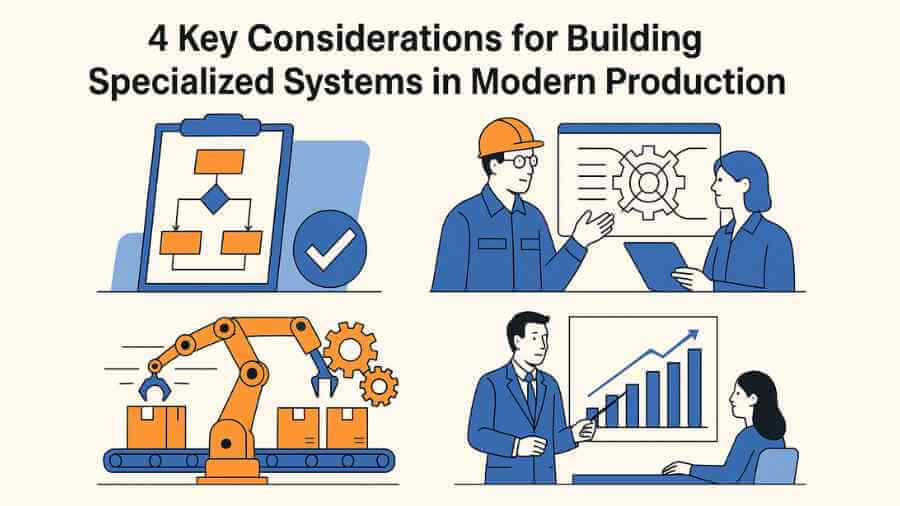4 Key Considerations for Building Specialized Systems in Modern Production

The era of one-size-fits-all manufacturing is fading. Modern production demands precision, efficiency, and the ability to adapt to unique product requirements and market changes. As a result, many companies are shifting away from generic machinery and moving toward specialized systems tailored to their specific operational needs. These custom solutions can dramatically increase output, improve quality control, and provide a significant competitive edge.
Building a specialized system, however, is a complex undertaking that requires careful planning and strategic execution. It’s not just about acquiring new hardware; it’s about creating a cohesive, integrated solution that aligns perfectly with your production goals. This guide explores four essential considerations for developing and implementing specialized systems that will drive your manufacturing processes forward.
1. Define Clear Project Scope and Objectives
Before a single blueprint is drawn, the most critical step is to define the project’s scope and objectives with absolute clarity. A poorly defined scope is one of the leading causes of project failure, leading to budget overruns, missed deadlines, and a final system that doesn’t meet expectations. Start by assembling a cross-functional team, including operators, engineers, maintenance staff, and management, to provide a holistic view of the requirements.
This initial phase should answer fundamental questions:
- What specific problem will this system solve?
- What are the target production rates, quality standards, and efficiency metrics?
- What is the available budget and desired timeline for completion?
- What are the physical constraints of the facility, such as space, power, and existing infrastructure?
A well-documented set of requirements serves as the foundation for the entire project. For instance, a food processing company looking to automate its packaging line would need to specify package sizes, sealing methods, and desired throughput (e.g., 100 units per minute). This level of detail ensures that all stakeholders have a unified vision and provides a clear benchmark for measuring the project’s success.
2. Prioritize Collaborative Design and Engineering
Building a specialized system is a collaborative effort between your internal team and external partners. The design phase is where your detailed requirements are translated into a functional engineering plan. Success here depends on open communication and deep collaboration with your chosen machine builders or system integrators. Look for partners who are willing to act as an extension of your team rather than just a vendor.
Effective collaboration involves regular design reviews, simulations, and prototype testing. Digital tools like 3D modeling and virtual reality (VR) simulations allow your team to visualize the system in its intended environment, identify potential ergonomic issues, and optimize the workflow before any metal is cut. For example, a manufacturer of medical devices could use a digital twin to simulate the assembly process, ensuring that the proposed system meets stringent regulatory and cleanroom standards. Engaging experienced machine manufacturers who offer robust engineering support can prevent costly modifications later and ensure the final system is both functional and user-friendly.
3. Emphasize Integration and Scalability
A new specialized system rarely operates in a vacuum. It must be seamlessly integrated with your existing production lines, control systems (like SCADA or MES), and data networks. A lack of proper integration can create bottlenecks that undermine the efficiency gains you sought to achieve. During the design phase, map out all hardware and software connection points. This includes physical conveyors, robotic handoffs, and digital data communication protocols.
Furthermore, think about the future. Your business needs will evolve, and your production system should be able to evolve with them. Design for scalability by building a modular system that allows for future upgrades or capacity expansion. For example, if you anticipate an increase in demand, design the system’s layout and control architecture to easily accommodate additional modules or robotic cells. A scalable design protects your initial investment and provides the flexibility needed to stay competitive in a dynamic market.
4. Plan for Comprehensive Training and Long-Term Support
The most advanced system in the world is ineffective if your team doesn’t know how to operate and maintain it properly. A comprehensive training program is essential for a smooth transition and long-term success. This training should be tailored to different roles—operators need to understand daily operations and safety procedures, while maintenance staff require in-depth knowledge of mechanical components, electrical systems, and troubleshooting protocols.
Beyond initial training, establish a long-term support and maintenance plan. This includes defining schedules for preventative maintenance, securing a reliable supply of spare parts, and having access to expert technical support when issues arise. A strong partnership with your system builder should include a clear service level agreement (SLA) that guarantees timely assistance. Proactive maintenance and ongoing support minimize downtime, extend the life of your equipment, and ensure your specialized system continues to deliver peak performance for years to come.



